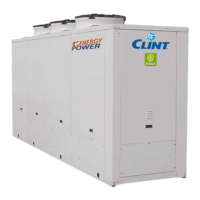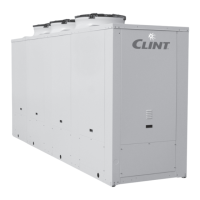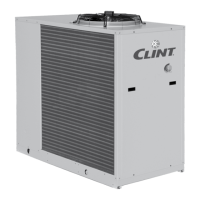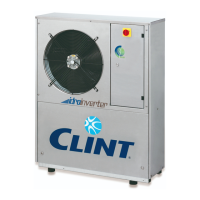17
CHA
5.2 COLLEGAMENTO IDRAULICO
5.2.1 Generalità
Per la realizzazione del circuito idraulico dell’acqua refri-
gerata è buona norma seguire attentamente le indicazioni
sotto riportate oltre che la normativa vigente.
Attenzione!
Le tubazioni idrauliche devono essere opportunamente
staffate per non gravare con il loro peso sul refrigeratore.
- Raccordare le tubazioni al refrigeratore tramite giunti
flessibili al fine di evitare la trasmissione delle vibrazioni
e compensare le dilatazioni termiche.
- Installare sulle tubazioni i seguenti componenti:
•valvolediintercettazione(saracinesche)perisolare
l’unità dal circuito idraulico;
•indicatoriditemperaturaepressioneperlanormale
manutenzione e controllo del gruppo;
•pozzetti sulle tubazioni d’ingresso ed uscita per i
rilievi di temperatura, qualora non fossero presenti
indicatori di temperatura;
•filtrometallico(tubazioneiningresso)areteconmaglia
non superiore ad 1mm, per proteggere lo scambiatore
da scorie o impurità presenti nelle tubazioni;
•valvoledisfiato,dacollocarenellepartipiùelevate
del circuito idraulico, per permettere lo sfogo dell’aria;
• vasodiespansione,(senongiàpresente)di-
mensionato in funzione della quantità d’acqua
contenuta nell’impianto e delle escursioni ter-
miche prevedibili, e valvole di carico automatica
per il mantenimento della pressione del sistema
e compensare le dilatazioni termiche del fluido.
•Ilserbatoioinerzialedeve essereinstallatosu
entrambi i circuiti (lato raffreddamento e lato
riscaldamento)sullatoutente.Questoconsen-
tedievitarel’avviamentotroppofrequentedei
compressoriel’attivazionedelleelettrovalvole.
•rubinetto di scarico e, ove necessario, serbatoio di
drenaggio per permettere lo svuotamento dell’impianto
per le operazioni di manutenzione o le pause stagionali.
•Quandol’unitàèaccesa,l’acquanegliscambiatori
termici(acquafredda,acquacalda,acquadipoz-
zo)devesemprescorrereadunaportatacostante
anchesenonrichiestodallatoutente/sistema.
Attenzione!
È indispensabile installare un flussostato di
sicurezza (se non già presente il flussostato/
pressostato differenziale) su un tratto rettilineo
di tubazione ad una distanza dall’uscita dello
scambiatore pari a non meno di 8-10 volte il dia-
metro della tubazione stessa. In caso contrario
la garanzia viene a decadere immediatamente.
5.2 WATER CONNECTIONS
5.2.1 General
Please carefully carry out the following instructions and
observe current law when installing the chilled water
circuit.
Attention!
The water pipes must be suitably supported with
brackets in order not to weigh on the chiller.
- Connect the pipes to the chiller with flexible joints in
order to prevent the transmission of vibrations and to
compensate thermal expansion.
- Install the following components on the pipes:
•shut-offvalve(moisters)forshuttingoffthewater
mains;
•temperatureandpressuregaugesforroutinemain-
tenance and inspection purposes;
•checkpointsontheinletandoutletpipesformeas-
uring temperatures if temperature indicators are not
fitted;
•metalfilter(inletpipe)withamaximummeshaperture
of 1 mm to protect the exchanger from waste or
impurities in the pipes;
•reliefvalves, fitted in the uppermost parts of the
water circuit, for expelling air;
• expansiontank(ifnotalreadyfitted)ofasuitable
size for the quantity of water contained in the
system and the expected temperature range,
and an automatic inlet valve for maintaining the
pressure of the system and compensating the
thermal expansion of the fluid.
•
Inertial tank must be installed on both circuits
(cooling and heatingside) on user side. This al-
lowstoavoidtoofrequentstart-up ofcompres-
sorsandactivationofelectro-valves.
•drainvalveor,wherenecessary,draintankforem-
ptying the circuit for maintenance operations or
seasonal shut downs.
•
When the Unit is ON, water on heat exchang-
ers(coldwater,hot water, well water) must be
alwaysrunningatconstantowevenifnotre-
quiredbytheuserside/system.
Attention!
Asafetyowswitchhastobeinstalled(ifthe
owswitch/differentialwaterpressureswitch
arenotalreadytted) along a straight section of
piping at a distance from the exchanger outlet
of not less than 8-10 times the diameter of the
piping. The guarantee will immediately become
null and void if the above is not complied with.

